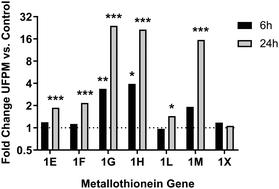当前位置:
X-MOL 学术
›
Metallomics
›
论文详情
Our official English website, www.x-mol.net, welcomes your feedback! (Note: you will need to create a separate account there.)
Upregulation of epithelial metallothioneins by metal-rich ultrafine particulate matter from an underground railway.
Metallomics ( IF 3.4 ) Pub Date : 2020-04-16 , DOI: 10.1039/d0mt00014k Matthew Loxham 1 , Jeongmin Woo 2 , Akul Singhania 2 , Natalie P Smithers 2 , Alison Yeomans 3 , Graham Packham 3 , Alina M Crainic 4 , Richard B Cook 4 , Flemming R Cassee 5 , Christopher H Woelk 2 , Donna E Davies 6
Metallomics ( IF 3.4 ) Pub Date : 2020-04-16 , DOI: 10.1039/d0mt00014k Matthew Loxham 1 , Jeongmin Woo 2 , Akul Singhania 2 , Natalie P Smithers 2 , Alison Yeomans 3 , Graham Packham 3 , Alina M Crainic 4 , Richard B Cook 4 , Flemming R Cassee 5 , Christopher H Woelk 2 , Donna E Davies 6
Affiliation

|
Airborne particulate matter (PM) is a leading cause of mortality and morbidity. However, understanding of the range and mechanisms of effects of PM components is poor. PM generated in underground railways is rich in metals, especially iron. In the ultrafine (UFPM; <0.1 μm diameter) fraction, the combination of small size and metal enrichment poses an unknown health risk. This study aimed to analyse transcriptomic responses to underground UFPM in primary bronchial epithelial cells (PBECs), a key site of PM deposition. The oxidation state of iron in UFPM from an underground station was determined by X-ray absorption near edge structure (XANES) spectroscopy. Antioxidant response was assayed using a reporter cell line transfected with an antioxidant response element (ARE)-luciferase construct. Differentiated PBECs were exposed to UFPM for 6 h or 24 h for RNA-Seq and RT-qPCR analysis. XANES showed predominance of redox-active Fe3O4, with ROS generation confirmed by induction of ARE-luciferase expression. 6 h exposure of PBECs to UFPM identified 52 differentially expressed genes (DEGs), especially associated with epithelial maintenance, whereas 24 h exposure yielded 23 DEGs, particularly involved with redox homeostasis and metal binding. At both timepoints, there was upregulation of members of the metallothionein family, low molecular weight proteins with antioxidant activity whose main function is binding and homeostasis of zinc and copper ions, but not iron ions. This upregulation was partially inhibited by metal chelation or ROS scavenging. These data suggest differential regulation of responses to metal-rich UFPM depending on exposure period, and highlight novel pathways and markers of PM exposure, with the role of metallothioneins warranting further investigation.
中文翻译:

来自地下铁路的富含金属的超细颗粒物对上皮金属硫蛋白的上调。
空气中的颗粒物 (PM) 是导致死亡和发病的主要原因。然而,人们对 PM 成分影响的范围和机制的理解很差。地下铁路产生的 PM 含有丰富的金属,尤其是铁。在超细(UFPM;<0.1 μm 直径)级分中,小尺寸和金属富集相结合会带来未知的健康风险。本研究旨在分析原代支气管上皮细胞 (PBEC) 中对地下 UFPM 的转录组学反应,这是 PM 沉积的关键部位。来自地下车站的 UFPM 中铁的氧化态是通过 X 射线吸收近边结构 (XANES) 光谱确定的。使用用抗氧化反应元件 (ARE)-荧光素酶构建体转染的报告细胞系测定抗氧化反应。分化的 PBEC 暴露于 UFPM 6 小时或 24 小时,用于 RNA-Seq 和 RT-qPCR 分析。XANES 显示出具有氧化还原活性的 Fe 的优势3 O 4,通过诱导 ARE-荧光素酶表达证实了 ROS 的产生。PBEC 暴露于 UFPM 6 小时确定了 52 个差异表达基因 (DEG),尤其与上皮维持相关,而暴露 24 小时产生了 23 个 DEG,尤其与氧化还原稳态和金属结合有关。在这两个时间点,金属硫蛋白家族的成员都有上调,这是一种具有抗氧化活性的低分子量蛋白质,其主要功能是结合和平衡锌和铜离子,但不是铁离子。这种上调被金属螯合或 ROS 清除部分抑制。这些数据表明,根据暴露时间对富含金属的 UFPM 的反应有不同的调节,并突出了 PM 暴露的新途径和标志物,金属硫蛋白的作用值得进一步研究。
更新日期:2020-04-16
中文翻译:

来自地下铁路的富含金属的超细颗粒物对上皮金属硫蛋白的上调。
空气中的颗粒物 (PM) 是导致死亡和发病的主要原因。然而,人们对 PM 成分影响的范围和机制的理解很差。地下铁路产生的 PM 含有丰富的金属,尤其是铁。在超细(UFPM;<0.1 μm 直径)级分中,小尺寸和金属富集相结合会带来未知的健康风险。本研究旨在分析原代支气管上皮细胞 (PBEC) 中对地下 UFPM 的转录组学反应,这是 PM 沉积的关键部位。来自地下车站的 UFPM 中铁的氧化态是通过 X 射线吸收近边结构 (XANES) 光谱确定的。使用用抗氧化反应元件 (ARE)-荧光素酶构建体转染的报告细胞系测定抗氧化反应。分化的 PBEC 暴露于 UFPM 6 小时或 24 小时,用于 RNA-Seq 和 RT-qPCR 分析。XANES 显示出具有氧化还原活性的 Fe 的优势3 O 4,通过诱导 ARE-荧光素酶表达证实了 ROS 的产生。PBEC 暴露于 UFPM 6 小时确定了 52 个差异表达基因 (DEG),尤其与上皮维持相关,而暴露 24 小时产生了 23 个 DEG,尤其与氧化还原稳态和金属结合有关。在这两个时间点,金属硫蛋白家族的成员都有上调,这是一种具有抗氧化活性的低分子量蛋白质,其主要功能是结合和平衡锌和铜离子,但不是铁离子。这种上调被金属螯合或 ROS 清除部分抑制。这些数据表明,根据暴露时间对富含金属的 UFPM 的反应有不同的调节,并突出了 PM 暴露的新途径和标志物,金属硫蛋白的作用值得进一步研究。



























 京公网安备 11010802027423号
京公网安备 11010802027423号